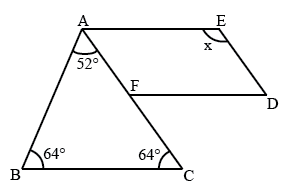8th Grade > Mathematics
UNDERSTANDING QUADRILATERALS MCQs
Total Questions : 464
| Page 8 of 47 pages
Answer: Option A. -> True
:
A
A polygon is called a regular polygon if it is equiangular and equilateral. i.e., All the angles are equal and measure of all the sides are equal.
Square is quadrilateral with all the angles equal to 90∘ and all the sides of equal length.
⟹ Square is a regular quadrilateral.
Hence, the given statement is true.
:
A
A polygon is called a regular polygon if it is equiangular and equilateral. i.e., All the angles are equal and measure of all the sides are equal.
Square is quadrilateral with all the angles equal to 90∘ and all the sides of equal length.
⟹ Square is a regular quadrilateral.
Hence, the given statement is true.
Answer: Option D. -> 140∘
:
D

∠DCB+∠ABC=180∘
[Adjacent angles of a parallelogram are supplementary]
⇒2t+7t=180∘
[∵∠DCB and ∠ABC are in ratio 2:7]
⇒t=20∘
∴∠DCB=2t=2×20∘=40∘
and ∠ABC=7t=7×20∘=140∘
Now, ∠DAB=∠DCB=40∘
[Opposite angles of a parallelogram are equal]
∠DAB+∠ADB+∠ABD=180∘
[Sum of the angles of a triangle]
⇒40∘+∠ADB+∠ABD=180∘
⇒∠ADB+∠ABD=140∘
:
D

∠DCB+∠ABC=180∘
[Adjacent angles of a parallelogram are supplementary]
⇒2t+7t=180∘
[∵∠DCB and ∠ABC are in ratio 2:7]
⇒t=20∘
∴∠DCB=2t=2×20∘=40∘
and ∠ABC=7t=7×20∘=140∘
Now, ∠DAB=∠DCB=40∘
[Opposite angles of a parallelogram are equal]
∠DAB+∠ADB+∠ABD=180∘
[Sum of the angles of a triangle]
⇒40∘+∠ADB+∠ABD=180∘
⇒∠ADB+∠ABD=140∘
:
If a diagonal of a quadrilateral bisects both the angles, then it is a rhombus.
:
Given, ABCD is a parallelogram, bisector of ∠A, bisects BC at F, i.e. ∠1=∠2, CF = FB.
Draw FE∥BA
ABFE is a parallelogram by construction [∵FE∥BA]
⇒∠1=∠6 [alternate angle]

But ∠1=∠2 [given]
∴∠2=∠6
AB = FB [opposite sides to equal angles are equal] ..... (i)
∴ABFEisarhombus.
Now, in ΔABO and ΔBOF, AB = BF [from Eq. (i)]
BO = BO [common]
AO = FO [diagonals of rhombus bisect each other]
∴ΔABO≅ΔBOF [by SSS]
∠3=∠4 [by CPCT]
Now, BF=12BC [given]
⇒BF=12AD [BC = AD]
⇒AE=12AD [BF = AE]
∴ E is the mid-point of AD.
:
In a square, all the sides and all the angles are equal.
Hence, square is an equiangular and equilateral polygon.
:
True
Rectangles are special parallelograms and satisfy all properties of parallelograms. Therefore, we can say that all rectangles are parallelograms but vice-versa is not true.
:
Let ABCD be a quadrilateral,
where ∠A=∠C=75∘ and ∠B=∠D=x [say]

Then, by the angle sum property of a quadrilateral, we have
∠A+∠B+∠C+∠D=360∘⇒75∘+x+75∘+x=360∘⇒2x=360∘−150∘⇒2x=210∘⇒x=105∘
Thus, other two angles are of 105∘ each.
Since, opposite angles are equal, therefore the quadrilateral is a parallelogram.
:
We know that the sum of all the angles of a quadrilateral is 360∘.
Also, an obtuse angle is more than 90∘ and less than 180∘.
Thus, all the angles of a quadrilateral cannot be obtuse.
Hence, at the most 3 angles can be obtuse.


















